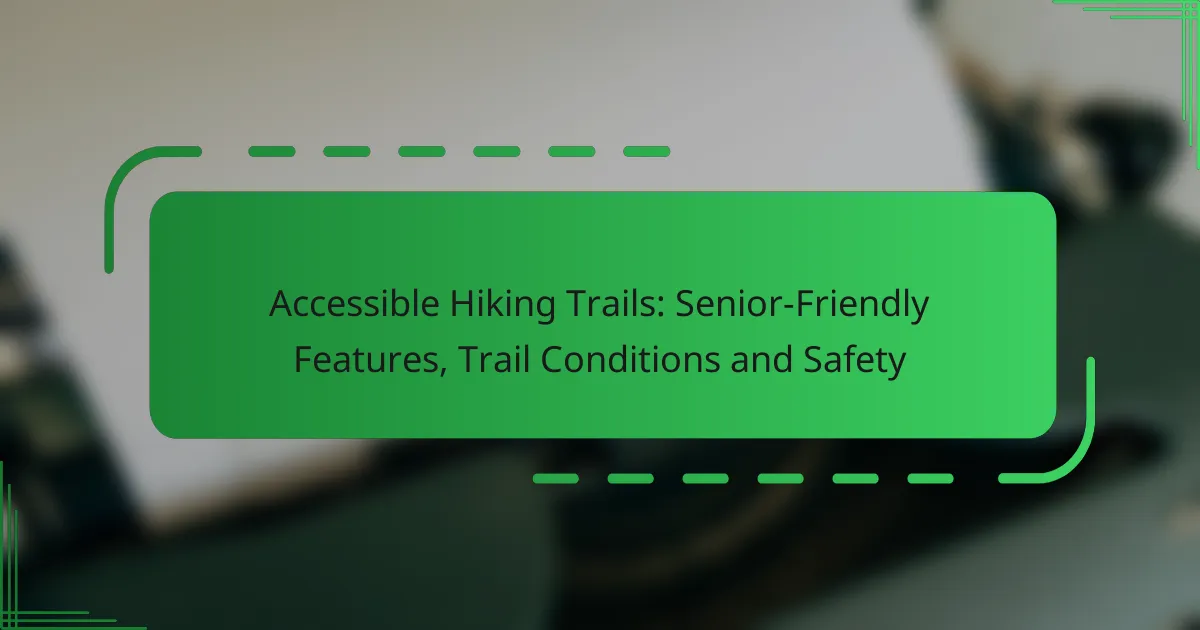Exploring family-friendly hiking trails can be a rewarding experience, offering a blend of accessibility, safety, and breathtaking scenery. These trails cater to families with children by providing various difficulty levels and essential amenities, ensuring everyone can enjoy the great outdoors. Prioritizing safety and accessibility allows families to create lasting memories while exploring nature together.

What are the best family-friendly hiking trails in the United States?
Some of the best family-friendly hiking trails in the United States offer a mix of accessibility, safety, and stunning views. These trails are designed to accommodate families with children, providing a range of difficulty levels and amenities.
Great Smoky Mountains National Park
The Great Smoky Mountains National Park features numerous family-friendly trails, such as the Laurel Falls Trail. This 2.6-mile round trip is relatively easy and leads to a beautiful waterfall, making it perfect for families with young children.
Safety is a priority here, with well-maintained paths and clear signage. Families should bring plenty of water and snacks, and consider visiting during the spring or fall for pleasant weather and fewer crowds.
Yosemite National Park
Yosemite National Park offers several accessible trails, including the Mirror Lake Trail. This 2-mile round trip is flat and provides breathtaking views of the surrounding granite cliffs, making it ideal for families.
When hiking in Yosemite, be aware of wildlife and always stay on marked trails. The park provides educational programs for children, enhancing the family experience while ensuring safety and enjoyment.
Acadia National Park
Acadia National Park is known for its stunning coastal views and family-friendly hiking options like the Jordan Pond Path. This 3.3-mile loop is relatively easy and features scenic views of the pond and surrounding mountains.
Families should check the weather before heading out, as conditions can change rapidly. The park also offers ranger-led programs that can engage children and enhance their understanding of the natural environment.
Shenandoah National Park
Shenandoah National Park has a variety of family-friendly trails, with the Stony Man Trail being a popular choice. This short, 1.6-mile hike leads to a spectacular viewpoint, making it a rewarding experience for families.
Parents should ensure children stay on the trail and are aware of their surroundings. The park’s Skyline Drive offers easy access to trailheads and beautiful overlooks, making it convenient for family outings.
Yellowstone National Park
Yellowstone National Park features family-friendly trails such as the Fountain Paint Pot Trail, which is about 0.5 miles long. This boardwalk trail is easy to navigate and showcases colorful geothermal features, captivating for both kids and adults.
Families should always stay on designated paths to protect the fragile environment and ensure safety. Visiting during the summer months provides the best weather, but be prepared for crowds and plan accordingly to enhance your experience.

How to ensure safety on family hikes?
To ensure safety on family hikes, it’s crucial to prepare adequately and stay vigilant. This includes using the right gear, sticking to marked paths, having a first aid kit, and educating children about local wildlife.
Use proper gear and clothing
Wearing appropriate gear and clothing is essential for a safe hiking experience. Choose sturdy footwear with good traction, and dress in layers to adapt to changing weather conditions. Lightweight, moisture-wicking fabrics can help keep everyone comfortable.
Consider using hiking poles for added stability, especially on uneven terrain. Always check the weather forecast before heading out to ensure you have the right gear for the day.
Stay on marked trails
Staying on marked trails is vital for safety and environmental protection. These paths are designed to minimize risks and reduce the impact on nature. Straying from them can lead to accidents or getting lost.
Familiarize yourself with the trail map and signage before starting your hike. Encourage children to follow the trail markers and explain the importance of staying on designated paths.
Keep a first aid kit handy
A well-stocked first aid kit is a must for any family hike. It should include basic supplies like adhesive bandages, antiseptic wipes, gauze, and pain relievers. Tailor the kit to your family’s specific needs, including any medications for allergies or chronic conditions.
Regularly check and replenish your first aid kit to ensure all items are in good condition and within their expiration dates. Teach older children how to use the kit in case of minor injuries.
Educate children about wildlife
Teaching children about local wildlife is crucial for their safety and the well-being of animals. Explain which animals they might encounter and how to behave around them. For example, remind them to observe from a distance and never feed wild animals.
Discuss the importance of respecting habitats and the role of wildlife in the ecosystem. This knowledge not only keeps children safe but also fosters a sense of responsibility towards nature.

What accessibility features should family-friendly trails have?
Family-friendly hiking trails should include accessibility features that ensure all visitors, including those with mobility challenges, can enjoy the outdoors safely and comfortably. Key features include wheelchair-friendly paths, rest areas with seating, accessible parking options, and high-quality trail surfaces.
Wheelchair-friendly paths
Wheelchair-friendly paths are essential for ensuring that individuals with mobility devices can navigate trails without barriers. These paths should be wide enough, typically at least 1 meter, and have gentle slopes to prevent difficulty in maneuvering. Look for trails that are marked as accessible and have minimal obstacles like roots or rocks.
When planning a hike, check trail maps or websites for information on wheelchair accessibility. Some parks may even provide virtual tours or photos to help assess the suitability of the paths.
Rest areas with seating
Rest areas with seating are crucial for family-friendly trails, allowing hikers to take breaks and enjoy the scenery. These areas should be strategically placed along the trail, especially at intervals of 500 meters or so, to accommodate varying levels of stamina. Seating should be sturdy and accessible, with options for those who may need back support.
Before heading out, verify the availability of rest areas on the trail map. Some trails may feature picnic tables or benches that are specifically designed for accessibility.
Accessible parking options
Accessible parking options are vital for ensuring that visitors can reach the trailhead without difficulty. Look for designated parking spaces that are wider than standard spots, typically around 2.4 meters, and located close to the trail entrance. These spaces should be clearly marked with the international symbol of accessibility.
Check the trail’s website or contact park services to confirm the number of accessible parking spots available. Some locations may require a permit or have specific time limits for parking, so it’s wise to plan ahead.
Trail surface quality
The quality of the trail surface significantly impacts accessibility for families and individuals with mobility challenges. Ideal surfaces are firm, stable, and smooth, such as compacted gravel or paved pathways. Avoid trails with loose gravel or uneven terrain, as these can pose hazards.
When choosing a trail, consider those that have been rated for accessibility. Many parks provide information on trail conditions, which can help you select a route that meets your family’s needs.

What scenic views can families expect on these trails?
Families can anticipate breathtaking vistas that enhance their hiking experience, featuring diverse landscapes such as majestic mountains, cascading waterfalls, and lush forests. These trails often provide accessible viewpoints that are safe for children and enjoyable for all ages.
Mountain vistas in the Rockies
The Rocky Mountains offer stunning panoramic views that are ideal for family hikes. Trails like the Bear Lake Trail in Colorado provide accessible paths leading to breathtaking mountain scenery, perfect for capturing family photos.
When hiking in the Rockies, consider trails with varying difficulty levels to match your family’s abilities. Many trails are well-marked and maintained, ensuring a safe experience while enjoying the dramatic peaks and valleys.
Waterfalls in the Smokies
The Great Smoky Mountains are renowned for their picturesque waterfalls, making them a popular choice for family-friendly hikes. Trails such as the Laurel Falls Trail lead to beautiful cascading waterfalls that are easily accessible and provide a perfect spot for a family picnic.
While exploring the Smokies, be mindful of trail conditions, especially after rain, as some paths may become slippery. Always check local guidelines for safety tips and recommended routes to ensure a pleasant outing with your family.



